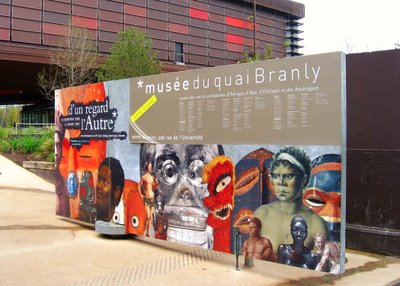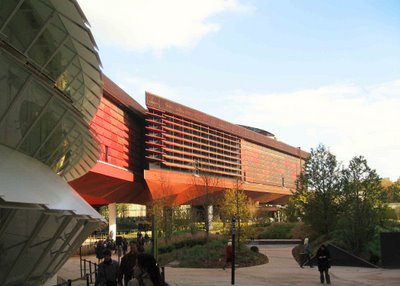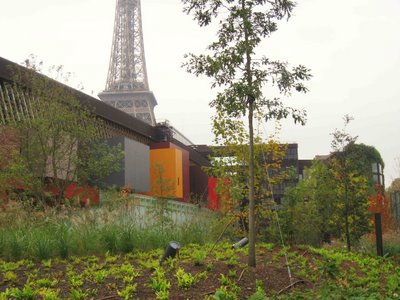
 During my recent trip to Paris, I visited a brand-new museum, the "Musee du quai Branly". Here are a few of the photos I took there. (Unfortunately, one is not allowed to take photos in the interior.)
During my recent trip to Paris, I visited a brand-new museum, the "Musee du quai Branly". Here are a few of the photos I took there. (Unfortunately, one is not allowed to take photos in the interior.)As described in the French foreign office announcement below, this new museum is dedicated to primitive art around the world. We only saw a bit of the collection, focusing on Oceana, but I intend to return several times to learn more about this vital theme about which I know so little. If you are in Paris, try it out.

Bridging cultures
Supported by French President Jacques Chirac, the Musée du Quai Branly is setting out to showcase the importance of the art and civilization of Africa, Asia, Oceania and the Americas at the crossroads of many different cultural, religious and historical influences. Situated on the banks of the Seine at the foot of the Eiffel Towel, the museum is a forum for scientific and artistic dialogue, a crossroads of exchange between the public, researchers, students as well as contemporary creators.
A new, multifaceted institution right in the heart of Paris
Designed by architect Jean Nouvel, the Musée du Quai Branly will exhibit 3,500 objects from this universal heritage permanently and devotes nearly 5,000 m2 to temporary exhibits. The public can also enjoy a 500-seat theatre, a screening room, several classrooms, a reading room and a multimedia library with a room for consulting highly valuable collections.
Conceived by Gilles Clément, featuring 180 trees that are more than de 15 meters tall and many different plant species, the garden has been designed to be a border of greenery surrounding the museum. 15,000 plants of 150 species from the entire world have been planted over 800 m², composing CNRS researcher Patrick Blanc’s plant wall, which covers the façade of the administrative building, “Branly”.
The “Université” building demonstrates the important place reserved for contemporary art at the Musée du Quai Branly. Eight of the most famous Australian Aboriginal artists have stamped their worldview on the ceilings and façade.
Facing the Seine, the 200-meter-long, 12-meter-high glass fence acts as an initial barrier to access to the museum and its activities. Protecting and promoting the collections
From October 2001 through September 2004, the collection construction site made it possible to identify, treat, decontaminate, clean, restore, computerize, take 2D and 3D photos and document all 300,000 works from the ethnology laboratory of the Musée de l’Homme and the Musée National des Arts d’Afrique et d’Océanie. This collection construction site is a technical and scientific first in France, serving as an example for many museums today.
The 3,500 works exhibited in the permanent collections are presented in a vast space with no partitions, spread out over large continental “zones”: Africa, Asia, Oceania and the Americas. The objects are accessible to as many people as possible thanks to contextualization supported by different levels of information: identification cards, texts or multimedia, including photographs, films and music.
In addition to the permanent collection displays, there will be ten temporary collections each year, distributed among the collections’ hanging galleries and the Galerie Jardin, a space for major international exhibitions, making it possible to present fundamental themes, while showcasing the treasures of the collections.
The Musée du Quai Branly: a new proposal
Resolutely modern, the institution structures its offering around several areas:
 Protection and promotion of leading collections, in association with temporary exhibits, capitalizing on the museum’s diverse resources, or taken from international collaborations. An informational Internet portal also provides access to all the collections.
Protection and promotion of leading collections, in association with temporary exhibits, capitalizing on the museum’s diverse resources, or taken from international collaborations. An informational Internet portal also provides access to all the collections.
 Research and education, with the creation of an interdisciplinary research centre. At once a museum and a university campus, the Musée du Quai Branly makes the information resources of its 230-seat multimedia library available to the general public. In addition, members of the research community have access to a top-notch study centre there.
Research and education, with the creation of an interdisciplinary research centre. At once a museum and a university campus, the Musée du Quai Branly makes the information resources of its 230-seat multimedia library available to the general public. In addition, members of the research community have access to a top-notch study centre there.
 A genuine crossroads of the world’s cultures, open to the greatest number of people, the Musée du Quai Branly also offers a programme of living shows in its theatre - performing arts, theatre, dance and music - thereby creating a veritable cultural city featuring non-European arts.
A genuine crossroads of the world’s cultures, open to the greatest number of people, the Musée du Quai Branly also offers a programme of living shows in its theatre - performing arts, theatre, dance and music - thereby creating a veritable cultural city featuring non-European arts.
Lastly, the Université Populaire du Quai Branly, accessible to all, opens the debate on historic and contemporary challenges and encourages dialogue on issues related to the Other through its series of lectures.
No comments:
Post a Comment